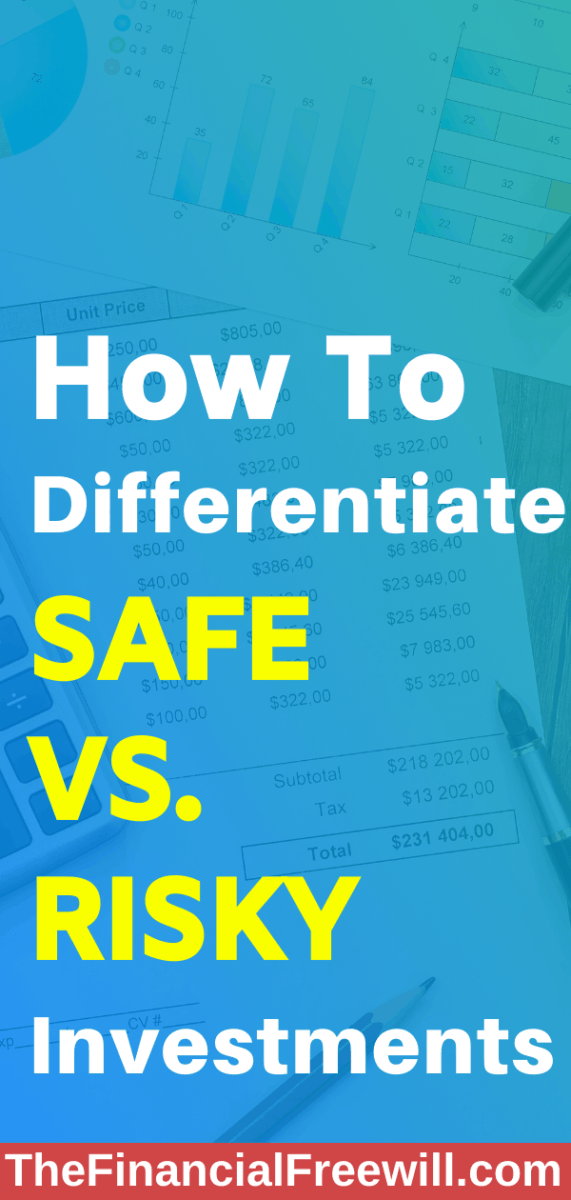This article may contain affiliate links. I might earn a small commission if you make any purchases through my links and it comes at NO cost to you. For more information, please read my Disclaimer page.
The topic of safe vs. risky investments is key to the health of your financial portfolio. There are several investment options out there and choosing one or more investment options that best fit your needs can be challenging.
So, how do you really determine investments that are safe vs. risky?
The difference between Safe & Risky investments lies in the amount of risk involved and the potential return it offers. Safe investments have lower risks and hence offer lower returns vs. risky investments.
It can be daunting to choose investment options, especially if you are starting.
Let’s look at some of the options in both categories, so it is easier for you to choose.

Safe Investments
1) Savings Account
Considered as one of the veterans as far as investment options are concerned, this is a good alternative to grow your money. A savings account is considered safe because it is FDIC insured in most cases.
This means that even if your financial institution fails, your account will be insured, and you can hope to get your money back (equal to or up to the insured amount). Given the recent increase in interest rates from the Federal Reserve, this could be a good option to park some cash and earn interest on that.
Pros:
–> They are the safest option to earn interest
–> Your money is readily available to withdraw any time
–> Majority of the savings accounts in the US are insured by Federal Deposit Insurance Corporation (FDIC) for up to $250,000/individual
–> You can open an account with little to no money
–> There is peace of mind with a savings account
Cons:
–> Since it is one of the safest investment options, the return is pretty low compared to CDs, T-bills, and stocks
–> You will not be realizing the full potential of your money if you just park your funds in an account that yields 2%
–> Some financial institutions will have withdrawal limits and the number of times you can transfer money out of the account.
–> Some financial institutions might require you to maintain a minimum balance every month

2) Certificate Of Deposits (CDs)
CDs are another popular investment vehicle, especially if you are looking for a safer option. With CDs, you cannot lose money, unless you withdraw before the end of the term.
When you invest in a CD, the bank promises to pay you an agreed upon interest rate for the specified time.
Remember, there might be penalties associated with early withdrawal from CDs, so make sure you are aware of the rules. Commercial banks generally issue CDs, and the best part is that the Federal Deposit Insurance Corporation (FDIC) insures them – generally up to US$250,000/individual.
The difference is that you can withdraw funds instantly from your savings account without any penalties compared to the savings account. You can earn a higher interest rate compared to the savings account.
Pros:
–> They are a safer investment option
–> CDs from banks and credit unions that are federally insured are backed by the trust of US government up to $250,000/individual
–> They provide better returns than savings account
–> The interest rate and term are pre-defined and fixed. This leaves no room for ambiguity
Cons:
–> Your funds are locked for the specified term
–> Early withdrawal from the CD will most likely result in penalties
–> The return is relatively lower compared to stocks
Download FREE Budget Checklist
>> 50+ List of Budget Items
>> Budget Items categorized into 3 sections: Income, Fixed Expenses, Variable Expenses

3) Treasury Bills (T-Bills)
T-bills are a short-term investment vehicle that you can use to earn a stable income in the form of interest payments. They are backed by the US Treasury Department and the maturity is typically one year or less.
So, you might be curious and wondering, what does the US treasury department need the money for? You see, all the construction related to bridges, roads, highways, schools, malls, and other public projects are funded in part by issuing T-bills.
You are basically lending money to the government and in return earning an interest. The maturity of the T-bill varies from a few days to 365 days.
When the bill matures (reaches the end of its specified term), you as an investor will receive the up-front amount you paid called the face-value or principal plus the interest earned over the specified time of the T-bill.
Pros:
–> The US government backs the T-bills
–> You can invest in a T-bill with as little as $100
–> You can buy and sell T-bills very easily in the secondary bond market
–> The maturity is less than a year which means your money is not locked in for an extended period
Cons:
–> The interest payment is not paid monthly or quarterly. You get paid at the end of the maturity
–> In some cases, the interest is lower than CDs and(or) a savings account
–> T-bills are influenced by interest rates. So, if the interest rates are rising, they are less attractive from an investment-return standpoint
4) Corporate Bonds
As the name suggests, these are bonds issued by the corporation. You as an investor will lend money to the corporation and in return earn an interest.
The ability of the corporation paying interest to investors is directly proportional to its ability to generate cash flow in the future.
Corporate bonds have a little higher risk than CDs or T-bills. Corporates issue these bonds as a form of debt financing; meaning they do not have to give up equity in order to bring in funds.
This form of financing can be a major source of capital infusion for most businesses. Corporate bonds are safer than stocks. When you buy a corporate bond, you are loaning money to the company.
On the other hand, when you buy a stock, you are investing in the company. As the value of the company and its profits increase, the stock price increases which results in a higher return on your investment.
So, with corporate bonds, you are only earning interest, and if a company goes bankrupt, you as a corporate bondholder will be paid first before the stockholder.
Pros:
–> They are safer than stocks
–> Corporate bonds are available in both fixed and floating interest rates
–> The yield (return) is higher than Savings account, CDs and T-bills
Cons:
–> They carry higher risk vs. US government bonds, CDs and T-bills.
–> The fluctuations in interest rates influence the interest payment on the corporate bond. The value is inversely proportional to the change in interest rates.

Risky Investments
1) Stocks
Stocks, also called equites are shares that you own as an investor in the company. As a shareholder, you get a piece of the company and get to benefit from the company’s growth and profits.
As the value of the company increases, so does the stock price and so does your initial investment.
There are a lot of options to choose from when investing in companies and based on the value and market capitalization, the stock of the company is either small-cap, mid-cap or large-cap.
Some of the most famous companies that issue stocks include Apple, Google, Facebook, Netflix, Exxon-Mobil, 3M, etc.)
Pros:
–> The return on a stock is higher than any of the above options mentioned under “Safe investment.”
–> You can quickly diversify your investment by investing in as many numbers of companies. This will spread your risk across different companies
–> Most of the stocks are traded on an exchange and hence the liquidity is very high; meaning, you can buy and sell quickly
–> Some companies also offer dividends (for, e.g., $1 for every share you own). Let’s say you own 100 shares of a company; you tend to earn an additional $100 just for owning the stock
Cons:
–> They are riskier than any of the safe investment options discussed above
–> The stock price can be very volatile especially during bad market days and you could potentially lose all your investment if the company goes bankrupt
–> You need to spend some time researching and analyzing the company before you buy stocks
2) Options
An option is a financial instrument based on an underlying asset (usually stock). This means that the value of the option is dependent on the stock. Option is a contract between a buyer and a seller giving them either the right or an obligation to buy or sell the option.
Options give the buyers the right, but not the obligation to buy or sell the underlying asset at an agreed upon date and price.
There are 2 basic types of options:
A CALL option allows the investor to buy an asset at a stated price with a pre-determined timeframe.
A PUT option allows the investor to sell the asset at a stated price with a pre-determined timeframe.
Pros:
–> You do not have to invest large sums of money upfront unlike when buying stock directly
–> There is no obligation for a buyer so you can either get out of the contract or let the contract expire worthlessly
Cons:
–> Little trickier and more complex than buying or selling a stock
–> The value of the option is inversely related to time and as time goes by, the probability of the option contract expiring worthless increases
3) Futures
A futures contract is like an options contract in which, the buyer and seller get into a contract for delivery on a specified future date.
Futures contract trading has come a long way. In the good old days, they used to be bought and sold in a trading pit through open yelling and hand signals but mostly traded electronically in today’s day and age.
Pros:
–> A large upfront investment is not required like in stocks
–> One of the trading requirements is that all positions should be closed by the end of day and so as an investor, you carry no risk into the next day
Cons:
–> It is riskier than investing in stocks or other safe investment options
–> As a futures investor/trader, you might end up opening and closing multiple trades, and this will result in higher commissions
–> Requires a lot of homework to come up with strategies and trading discipline
Download FREE Budget Checklist
>> 50+ List of Budget Items
>> Budget Items categorized into 3 sections: Income, Fixed Expenses, Variable Expenses

4) Cryptocurrency
This is one of the newest inventions of this decade. It is a form of digital currency that has certain protocols built in to avoid any fake transactions and make them secure.
Privacy is at the core of what it stands for. It is a currency that is decentralized; meaning no one controls the currency.
Cryptocurrency has gained tremendous traction in the last 5-7 years, but significant challenges remain in incorporating them in daily life
Pros:
–> Security and privacy are major focus areas
–> Low transaction cost compared to other methods like PayPal
–> It is decentralized; no one controls it
–> Transactions are hard to fake, quick and less fraudulent
Cons:
–> Limited acceptability by vendors
–> Extremely volatile, so price fluctuation is significant
–> Very risky compared to stocks, options, and futures
–> Tax implications are unclear and fuzzy
The above investment options are just a few of the many options available to you. I would recommend starting slow, understanding the various options, doing the homework and consistently investing.
Please feel free to share your experiences and thoughts by dropping in a comment below!



Pingback: Types Of Stocks to Invest - Diversify Your Investments For Steady Returns!
Pingback: How To Pay Off Debt: 7 Steps To Help You Payoff Your Debt Faster
Nice.I never knew about CD, T bills or anything like that. Most of my knowledge was about 401K, mutual funds, index funds and stocks. Any advice you’d say for someone that’s low income?
Thanks Thomas! 401k and mutual funds is what I would focus on for low income.